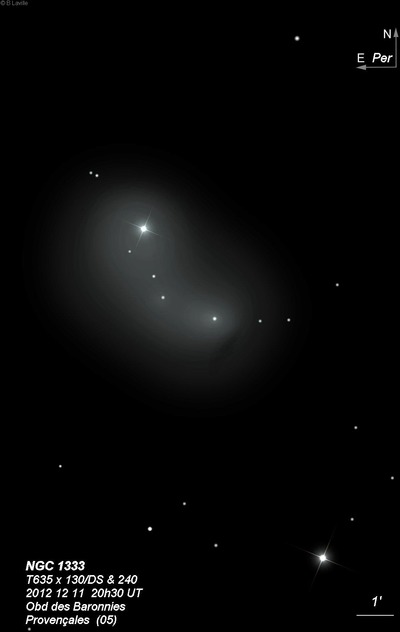
Eduard Sch?nfeld discovered NGC 1333 = Au 17 on 31 Dec 1855 with a 3-inch Fraunhofer refractor at Bonn Observatory, while measuring stars for the BD catalogue (NGC 1333 received the number BD +30? 548). He noted it as a nebulous star. The discovery was not announced until 1862 in AN 1391 and Auwers included it the same year as #17 in his "Verzeichnis neuer Nebelflecke" (list of new nebulae). In the meantime Horace Tuttle independently discovered the object on 5 Feb 1859 with a 3-inch comet-seeker and Bond (director of Harvard College) announced it as new in 1859MNRAS..19..224B: "it follows a star of the 9-10 mag by 6 seconds, and is 2' north of it. It is barely visible in a telescope of 3 in aperture."
In September 1862 d'Arrest noted it was as faint as a Herschel nebula of third class with the 11-inch refractor at Copenhagen, but since Tuttle's (independent) discovery was made using a 3-inch scope, he thought it might be a variable nebula (a popular topic among visual observers). Winnecke also took the view that it "must be a new one" as it was listed neither in the Slough catalogue nor Auwers' lists. Based on all the observations, Sch?nfeld reached the conclusion this case was a "...striking example of how the visibility of very faint, large diffuse nebulae depends on the magnification, air transparency and adaptation to the dark of the eye, so that, compared with ordinary fixed stars, aperture takes a back seat." In 1914 Barnard photographed the region at Yerkes Observatory and noted the nebula appeared "roundish and not symmetrical with respect to the star - its center seems to be several minutes to the south." Summarized from Harold Corwin's identification notes and Steinicke's "Observing and Cataloguing Nebulae and Star Clusters".
300/350mm - 13.1" (11/29/86): fairly bright nebula, large, extends SSW of a mag 9.5 star, oval, slightly brighter at the south edge.
400/500mm - 17.5" (2/9/02): bright, interesting reflection nebula at 140x. Apparently illuminated by a mag 10 star oddly offset at the NE end of the glow. The appearance is irregular; extending ~10'x6' SW-NE in the general direction of a mag 10 star 11' SW. The SW extension contains a couple of faint mag 14 stars and ends at a small, brighter knot that appears to surround a very faint star or stars. The field is oddly void of faint stars and there is a large starless region to the north (this is the dark nebula Barnard 2).
17.5" (12/8/90): fairly bright reflection nebula surrounds a mag 10 star that is offset to the northeast side of the nebula. This is a large object, about 10'x6' and elongated SW-NE. There is a bright knot in the southwest end. Two or three 15th magnitude stars are superimposed.
Notes by Steve Gottlieb